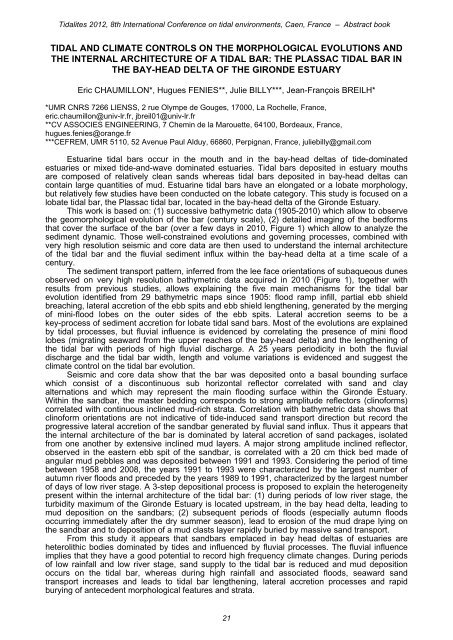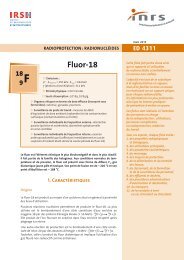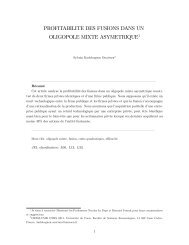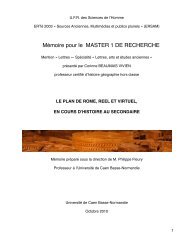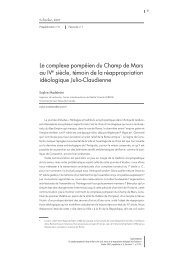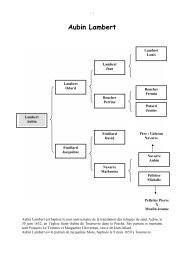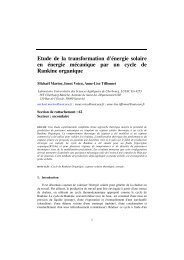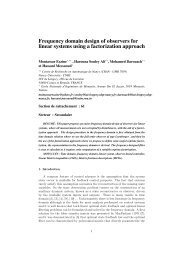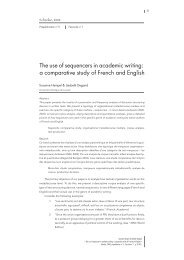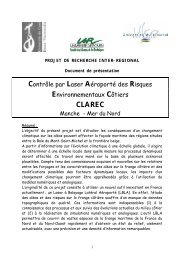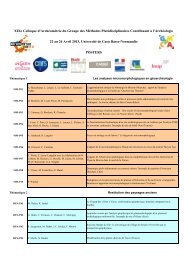programme tuesday, july, 31 - Université de Caen Basse Normandie
programme tuesday, july, 31 - Université de Caen Basse Normandie
programme tuesday, july, 31 - Université de Caen Basse Normandie
You also want an ePaper? Increase the reach of your titles
YUMPU automatically turns print PDFs into web optimized ePapers that Google loves.
Tidalites 2012, 8th International Conference on tidal environments, <strong>Caen</strong>, France – Abstract book<br />
TIDAL AND CLIMATE CONTROLS ON THE MORPHOLOGICAL EVOLUTIONS AND<br />
THE INTERNAL ARCHITECTURE OF A TIDAL BAR: THE PLASSAC TIDAL BAR IN<br />
THE BAY-HEAD DELTA OF THE GIRONDE ESTUARY<br />
Eric CHAUMILLON*, Hugues FENIES**, Julie BILLY***, Jean-François BREILH*<br />
*UMR CNRS 7266 LIENSS, 2 rue Olympe <strong>de</strong> Gouges, 17000, La Rochelle, France,<br />
eric.chaumillon@univ-lr.fr, jbreil01@univ-lr.fr<br />
**CV ASSOCIES ENGINEERING, 7 Chemin <strong>de</strong> la Marouette, 64100, Bor<strong>de</strong>aux, France,<br />
hugues.fenies@orange.fr<br />
***CEFREM, UMR 5110, 52 Avenue Paul Alduy, 66860, Perpignan, France, juliebilly@gmail.com<br />
Estuarine tidal bars occur in the mouth and in the bay-head <strong>de</strong>ltas of ti<strong>de</strong>-dominated<br />
estuaries or mixed ti<strong>de</strong>-and-wave dominated estuaries. Tidal bars <strong>de</strong>posited in estuary mouths<br />
are composed of relatively clean sands whereas tidal bars <strong>de</strong>posited in bay-head <strong>de</strong>ltas can<br />
contain large quantities of mud. Estuarine tidal bars have an elongated or a lobate morphology,<br />
but relatively few studies have been conducted on the lobate category. This study is focused on a<br />
lobate tidal bar, the Plassac tidal bar, located in the bay-head <strong>de</strong>lta of the Giron<strong>de</strong> Estuary.<br />
This work is based on: (1) successive bathymetric data (1905-2010) which allow to observe<br />
the geomorphological evolution of the bar (century scale), (2) <strong>de</strong>tailed imaging of the bedforms<br />
that cover the surface of the bar (over a few days in 2010, Figure 1) which allow to analyze the<br />
sediment dynamic. Those well-constrained evolutions and governing processes, combined with<br />
very high resolution seismic and core data are then used to un<strong>de</strong>rstand the internal architecture<br />
of the tidal bar and the fluvial sediment influx within the bay-head <strong>de</strong>lta at a time scale of a<br />
century.<br />
The sediment transport pattern, inferred from the lee face orientations of subaqueous dunes<br />
observed on very high resolution bathymetric data acquired in 2010 (Figure 1), together with<br />
results from previous studies, allows explaining the five main mechanisms for the tidal bar<br />
evolution i<strong>de</strong>ntified from 29 bathymetric maps since 1905: flood ramp infill, partial ebb shield<br />
breaching, lateral accretion of the ebb spits and ebb shield lengthening, generated by the merging<br />
of mini-flood lobes on the outer si<strong>de</strong>s of the ebb spits. Lateral accretion seems to be a<br />
key-process of sediment accretion for lobate tidal sand bars. Most of the evolutions are explained<br />
by tidal processes, but fluvial influence is evi<strong>de</strong>nced by correlating the presence of mini flood<br />
lobes (migrating seaward from the upper reaches of the bay-head <strong>de</strong>lta) and the lengthening of<br />
the tidal bar with periods of high fluvial discharge. A 25 years periodicity in both the fluvial<br />
discharge and the tidal bar width, length and volume variations is evi<strong>de</strong>nced and suggest the<br />
climate control on the tidal bar evolution.<br />
Seismic and core data show that the bar was <strong>de</strong>posited onto a basal bounding surface<br />
which consist of a discontinuous sub horizontal reflector correlated with sand and clay<br />
alternations and which may represent the main flooding surface within the Giron<strong>de</strong> Estuary.<br />
Within the sandbar, the master bedding corresponds to strong amplitu<strong>de</strong> reflectors (clinoforms)<br />
correlated with continuous inclined mud-rich strata. Correlation with bathymetric data shows that<br />
clinoform orientations are not indicative of ti<strong>de</strong>-induced sand transport direction but record the<br />
progressive lateral accretion of the sandbar generated by fluvial sand influx. Thus it appears that<br />
the internal architecture of the bar is dominated by lateral accretion of sand packages, isolated<br />
from one another by extensive inclined mud layers. A major strong amplitu<strong>de</strong> inclined reflector,<br />
observed in the eastern ebb spit of the sandbar, is correlated with a 20 cm thick bed ma<strong>de</strong> of<br />
angular mud pebbles and was <strong>de</strong>posited between 1991 and 1993. Consi<strong>de</strong>ring the period of time<br />
between 1958 and 2008, the years 1991 to 1993 were characterized by the largest number of<br />
autumn river floods and prece<strong>de</strong>d by the years 1989 to 1991, characterized by the largest number<br />
of days of low river stage. A 3-step <strong>de</strong>positional process is proposed to explain the heterogeneity<br />
present within the internal architecture of the tidal bar: (1) during periods of low river stage, the<br />
turbidity maximum of the Giron<strong>de</strong> Estuary is located upstream, in the bay head <strong>de</strong>lta, leading to<br />
mud <strong>de</strong>position on the sandbars; (2) subsequent periods of floods (especially autumn floods<br />
occurring immediately after the dry summer season), lead to erosion of the mud drape lying on<br />
the sandbar and to <strong>de</strong>position of a mud clasts layer rapidly buried by massive sand transport.<br />
From this study it appears that sandbars emplaced in bay head <strong>de</strong>ltas of estuaries are<br />
heterolithic bodies dominated by ti<strong>de</strong>s and influenced by fluvial processes. The fluvial influence<br />
implies that they have a good potential to record high frequency climate changes. During periods<br />
of low rainfall and low river stage, sand supply to the tidal bar is reduced and mud <strong>de</strong>position<br />
occurs on the tidal bar, whereas during high rainfall and associated floods, seaward sand<br />
transport increases and leads to tidal bar lengthening, lateral accretion processes and rapid<br />
burying of antece<strong>de</strong>nt morphological features and strata.<br />
21


